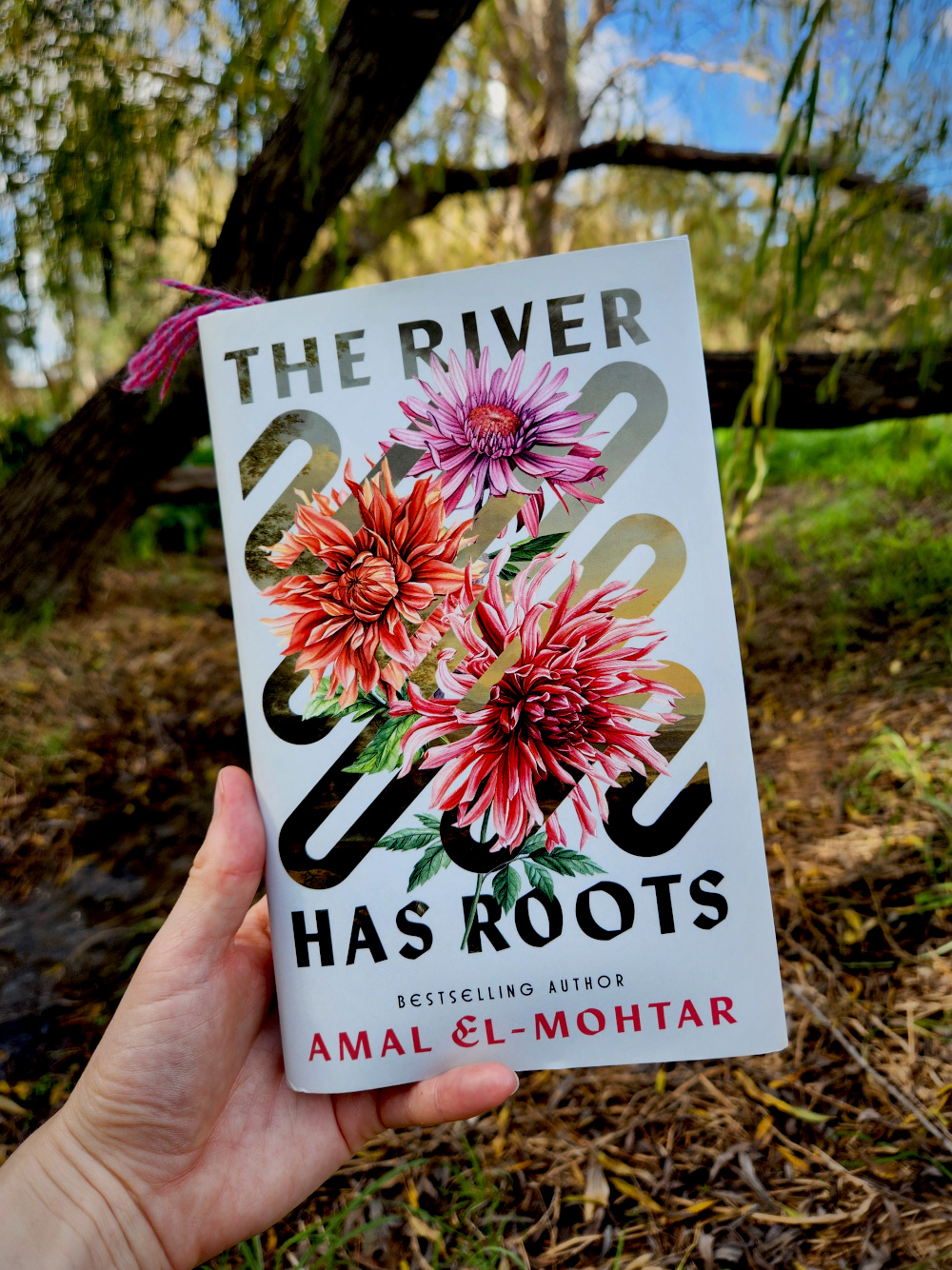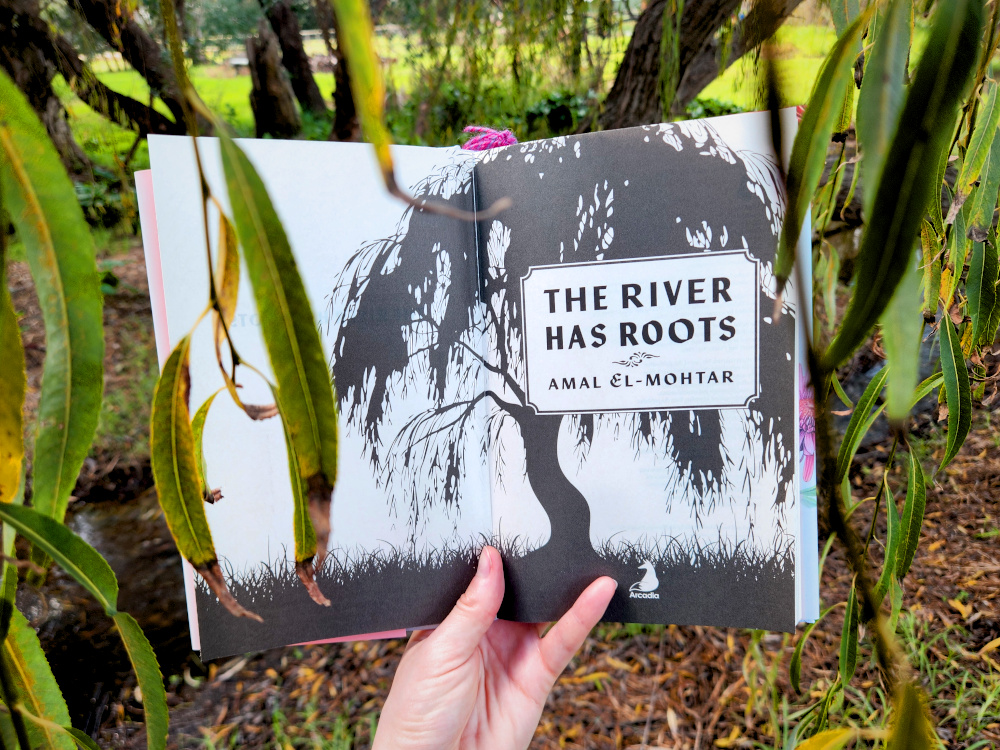There is a creek by my house. Just a small one, which fills with running rainwater in winter, then dries out again in summer. Along its banks is a copse of willow trees. Their leaves are lush and green in summer, but yellow and fall away in winter. When the creek burbled with water, and the willow leaves began to yellow, I sat here to read Amal El-Mohtar’s 2025 fantasy novella The River Has Roots.
The River Has Roots, too, begins with willows by the water. Not a piddly little creek, but a great river running through Arcadia—perhaps better known as fairyland—its waters brimming with grammar.
There was a time when grammar was wild—when it shifted shapes and unleashed new forms out of old. Grammar, like gramarye, like grimmoire. What is magic but a change in the world? What is conjugation but transformation, one thing into another? She runs; she ran; she will run again.
The river runs past two great willows, and then it continues tamely on through the town of Thistleford. Here, we meet our protagonists: the sisters Esther, and Ysabel Hawthorn who together sing to the willow trees. The younger sister, Ysabel, likes murder ballads while the elder sister, Esther, likes riddle songs. Esther has two suitors; Samual Pollard, from Thistleford, who wants the Hawthorn family’s land, and Rin, from Arcadia, who taught Esther to play the harp.
The River Has Roots grows from the tradition of folk songs. El-Mohtar re-imagines the murder ballads of The Two Sisters; she was inspired by “The Bonny Swans” by Loreena McKennitt, and “Two Sisters” by Emily Portman. The two sisters of The River Has Roots sing a song to their willows based on the Palestinian folk song “Tarweedeh Shmaali”, or “Lover’s Hymn”.
But, The River Has Roots features a strong bond between the sisters Esther and Ysabel, rather than the bitter animosity of The Two Sisters. “Ultimately, Esther and Ysabel came from a desire to put more loving sisters on the page”, El-Mohtar says; Esther and Ysabel’s relationship was inspired by El-Mohtar’s own relationship with her sister Dounya. Their own childhood escapade getting lost chasing a chicken even features in the story. As someone who loves my siblings dearly, I appreciate this greatly.
The narration at times takes a conversational tone, wandering off on tangents (“Now where were we”) before circling back to the main sequence of events (“But we were speaking of the Hawthorn family, weren’t we”). Like a folk tale, I can just imaging sitting down to hear this tale recounted; perhaps by fireside, perhaps over lunch. As to the veracity—did those sisters really get lost in fairyland while chasing that chicken—well, that’s the way I heard it.

The River Has Roots is El-Mohtar’s first independent novella, though in 2019 she co-authored the Hugo and Nebula Award winning science fiction novella This Is How You Lose The Time War with Max Gladstone. In this novella, rival agents Red and Blue fall in love through a series of poetic—if mind-bending—letters, while facing of in a war stretching across time and space.
If you are familiar with This Is How You Lose The Time War, you will know it has a convoluted narrative structure; it jumps between new, alien settings and doubles back on its own timeline. The River Has Roots has a simpler structure. The setting remains rooted in the river, and the timeline has only slight divergences from chronological. This makes The River Has Roots easier to follow, but if you loved the creative structure of This Is How You Lose The Time War it may be a letdown.
Still, The River Has Roots is written in a similarly poetic style to This Is How You Lose The Time War. I find it beautiful, but I can see others finding the prose a bit too purple. And, the magic of grammar in The River Has Roots is just as strange, and unexplained as the letters read in boiling water, and the rings of trees in This Is How You Lose The Time War. Again, this is something I enjoy, but it may frustrate those who prefer more logical, rule-bound magic systems.
A swan’s language is a swirl of currents, in water and air: a swan’s body reads a kind of literature in the waves and clouds before launching herself between their lines.
The River Has Roots is a short story. At only one hundred pages, I found it easy enough to read in a spare afternoon. So, if you’re looking to immerse yourself in a long narrative, this is not the book for you. But, if you enjoy quick, fairytale-esque stories like A Spindle Splintered by Alix E. Harrow, I highly recommend The River Has Roots.
